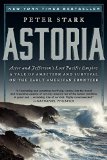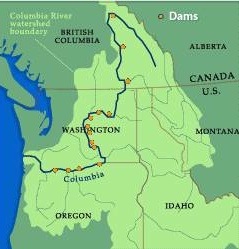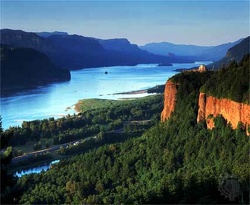Summary | Excerpt | Reviews | Beyond the Book | Read-Alikes | Genres & Themes | Author Bio
John Jacob Astor and Thomas Jefferson's Lost Pacific Empire: A Story of Wealth, Ambition, and Survival
by Peter Stark

Critics' Opinion:
Readers' Opinion:
First Published:
Mar 2014, 384 pages
Paperback:
Feb 2015, 400 pages
 Book Reviewed by:
Book Reviewed by:
Kim Kovacs
Buy This Book
This article relates to Astoria
The mouth of the Columbia River – where it meets the Pacific Ocean at the state border between Oregon and Washington – was John Jacob Astor's intended location for a trading center.
 The Columbia River flows for 1,243 miles from its source at Columbia Lake, British Colombia through Washington and Oregon. It is the largest river flowing from North America into the Pacific. It is the fourth largest river by volume in North America (behind the Mississippi, St. Lawrence and MacKenzie rivers) with a watershed that drains an area the size of France (259,000 square miles) from seven states and British Columbia. The Columbia's largest tributary is the Snake River, which travels over a thousand miles from its source in Yellowstone National Park to its confluence with the Columbia in eastern Washington.
The Columbia River flows for 1,243 miles from its source at Columbia Lake, British Colombia through Washington and Oregon. It is the largest river flowing from North America into the Pacific. It is the fourth largest river by volume in North America (behind the Mississippi, St. Lawrence and MacKenzie rivers) with a watershed that drains an area the size of France (259,000 square miles) from seven states and British Columbia. The Columbia's largest tributary is the Snake River, which travels over a thousand miles from its source in Yellowstone National Park to its confluence with the Columbia in eastern Washington.
It's believed that the waterway was formed between 12,000 and 19,000 years ago at the end of the last Ice Age. Massive ice dams blocked glacial melt and created a huge lake in Montana, referred to in modern times as Lake Missoula. The dams periodically gave way, sending massive floods across Washington and Oregon and carving out the Columbia Basin down which the river now flows.
Archaeological evidence indicates that the regions around the Columbia were inhabited for at least 15,000 years, and Native Americans depended on the river for transportation, trade and sustenance. In addition to hunting deer, elk and bighorn sheep, tribes fished for salmon, steelhead, sturgeon and lamprey eel. Before 1850 the Columbia supported the largest known salmon and steelhead, with up to 16 million fish returning to spawn each year. A Native American legend states that the fish were so numerous one could walk across the river on their backs.
 The first Europeans to visit the Columbia were likely Spanish explorers who ventured into the river's mouth in 1775, followed in 1792 by Boston trader Robert Gray who sailed up the river in a ship named the Columbia (from which the river got its name). The Lewis and Clark expedition arrived more than a decade later, wintering at the mouth of the Columbia in 1805 and 1806. Astor's 1811 expedition hoped to keep England from being able to claim the rich territory along the lower Columbia, but circumstances (outlined in Stark's book) caused the Astorians to give up their post to the British North West Company controlled by Scottish trappers and run under the auspices of England; however the area reverted permanently to U.S. control after the signing of the 1846 Oregon Treaty. Colonists moving west along the Oregon Trail developed the river for their own uses. The first fish cannery opened in 1866, and by 1881 some 30 Columbia River canneries were supplying world markets (in 1883 21,500 tons were shipped to Great Britain alone).
The first Europeans to visit the Columbia were likely Spanish explorers who ventured into the river's mouth in 1775, followed in 1792 by Boston trader Robert Gray who sailed up the river in a ship named the Columbia (from which the river got its name). The Lewis and Clark expedition arrived more than a decade later, wintering at the mouth of the Columbia in 1805 and 1806. Astor's 1811 expedition hoped to keep England from being able to claim the rich territory along the lower Columbia, but circumstances (outlined in Stark's book) caused the Astorians to give up their post to the British North West Company controlled by Scottish trappers and run under the auspices of England; however the area reverted permanently to U.S. control after the signing of the 1846 Oregon Treaty. Colonists moving west along the Oregon Trail developed the river for their own uses. The first fish cannery opened in 1866, and by 1881 some 30 Columbia River canneries were supplying world markets (in 1883 21,500 tons were shipped to Great Britain alone).
Today the Columbia hosts one of the world's largest hydro-power systems with fourteen dams on the main river and over 450 distributed throughout the whole basin. It produces half the electricity in the Pacific Northwest, and is linked to the California power grid so surplus power can be sold to their utilities when water flow is high. Locks have been installed and the river has been dredged as far as Lewiston, Idaho (more than 460 miles inland from the Pacific Ocean) to facilitate shipping; more than 40% of all wheat exported by the United States spends time being barged along the Columbia.
Unfortunately the development has heavily polluted the river and had a dramatic impact on the native wildlife, greatly reducing the populations of beaver, deer, elk, bear, sheep, waterfowl and upland birds including eagles, ospreys, hawks, and falcons. The dams have had a negative effect on salmon and steelhead runs, blocking spawning routes and making the channel too deep for egg-laying, dropping populations to below one million returning salmon. In recent years the power companies responsible for the dams have committed to re-establishing the fish runs, removing some of the older dams, and installing fish ladders to help the returning salmon bypass the dams. They have increased the water flow over the dams during the spring when juvenile salmon are heading downstream to help them avoid the power-generating turbines. Dozens of fish hatcheries also bolster fish numbers, but the practice has led to controversy, with some environmental groups stating that hatchery-bred fish pass on genetic defects to wild populations, thereby weakening them.
Map of river from Columbia River Walleye Guides
Picture of Colombia River from Center for Natural Resources and Environmental Policy
Filed under Places, Cultures & Identities
![]() This "beyond the book article" relates to Astoria. It originally ran in April 2014 and has been updated for the
February 2015 paperback edition.
Go to magazine.
This "beyond the book article" relates to Astoria. It originally ran in April 2014 and has been updated for the
February 2015 paperback edition.
Go to magazine.





The House on Biscayne Bay
by Chanel Cleeton
As death stalks a gothic mansion in Miami, the lives of two women intertwine as the past and present collide.

The Flower Sisters
by Michelle Collins Anderson
From the new Fannie Flagg of the Ozarks, a richly-woven story of family, forgiveness, and reinvention.

The Funeral Cryer by Wenyan Lu
Debut novelist Wenyan Lu brings us this witty yet profound story about one woman's midlife reawakening in contemporary rural China.
Your guide toexceptional books
BookBrowse seeks out and recommends the best in contemporary fiction and nonfiction—books that not only engage and entertain but also deepen our understanding of ourselves and the world around us.